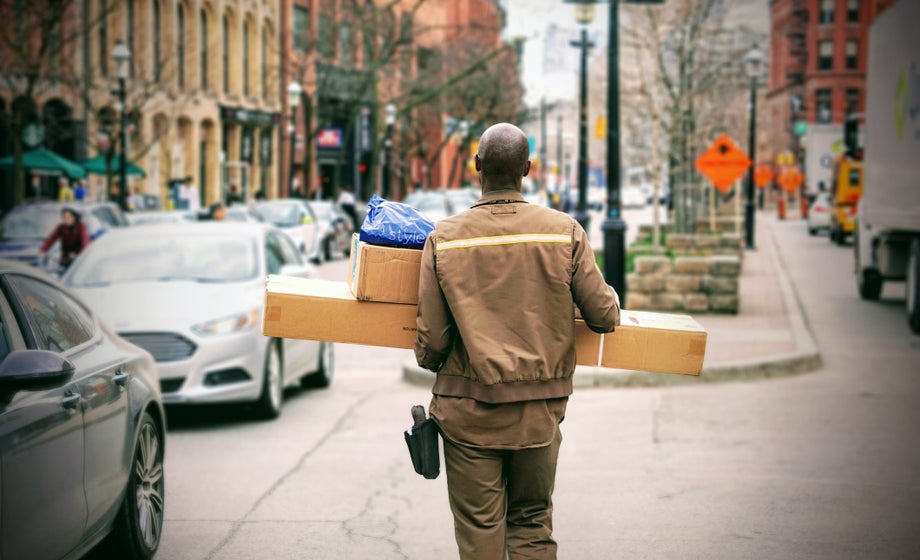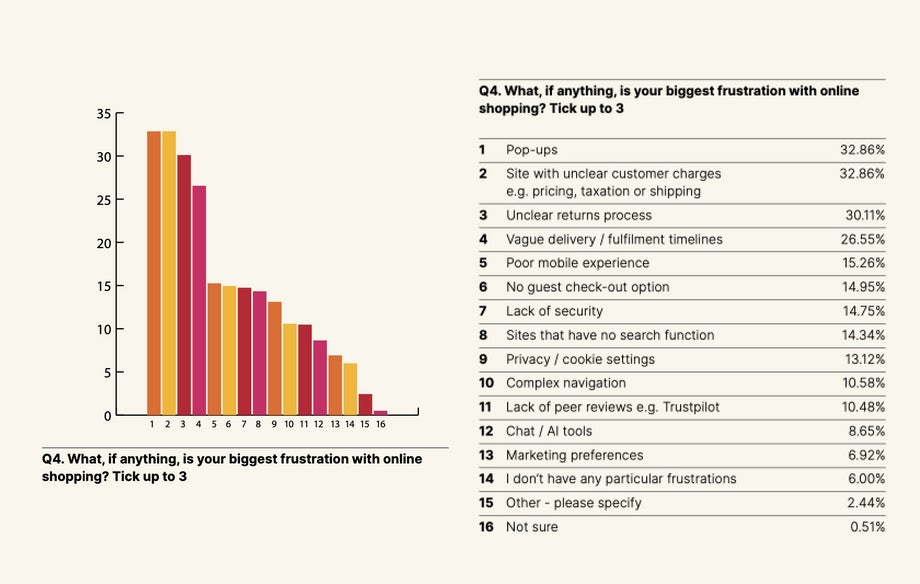

21.11.20236 mins read
Black Friday and Cyber Monday are now two of the biggest shipping days of the year. And while inflation and political unrest have dented consumer spending power, the forecast for this year's Black Friday Cyber Monday (BFCM) weekend is optimistic. According to one source, 66% of UK consumers and 67% globally anticipate spending as much or more on this BFCM compared to the previous year.
The brands who benefit will clap themselves on the back and, with boosted revenues, go into 2024 on a high. Those who don’t…. Well, the new year will either present an opportunity for analysis and change or a day of reckoning.
Multiple factors influence who wins and who loses, many of which are outside a brand’s control. Sometimes, a brand will just hit a home run and dominate because they are on everyone’s must-have list. This year, Barbie merchandise will no doubt appear on many lists. However, others, such as what kind of buying journey or shopping experience you are offering your customer, are most definitely within a brand’s control.
And this is where I see huge opportunities that are often missed.
Regardless of the location, brick-and-mortar or TikTok, customers have made it very clear that they want convenient, frictionless shopping. They want to enjoy the experience, whether buying a gift for an annoying uncle or someone special. For most of us, this is our hard-earned money, and when parting with it, we want, in addition to the item, something in return. It’s an intangible other sense that avid shoppers describe as a kind of personalised euphoria. I see it as feeling valued - that the brand is acknowledging that I am choosing them over their competitors, and they show their appreciation for my decision to do so through the customer experience.
Despite some predictions, COVID did not bring about the end of the high street. People continue to flock back to physical shops, and brands are rightly investing heavily to elevate the in-store experience. One recent report revealed that 93% of European retailers surveyed see experiential retail as the key to future-proofing, and over two-thirds are investing in technology to make new omnichannel experiences for customers. These experiences encompass everything from self-service checkouts to some fashion shops in Germany putting radio-frequency identification(RFID) tags on their merchandise, enabling shoppers to try them on. The mirrors transform into a screen showing how the item was made and what it looked like on the runway.
However, while people still want a physical shopping experience, they also continue to shop online and definitely want to see improvements in the delivery experience. The UK eCommerce market alone is predicted to expand by nearly 26%, reaching over £260 billion in 2025. When we look at Europe, that figure is even bigger. Shoppers are saying they want both, which is why investing in delivering a superior and integrated omnichannel experience that streamlines both online and offline is absolutely critical for market gain, customer retention, and future growth.
Buying online, even if it begins and/or ends offline, takes the customer on a different journey, and we examined what this looks like in All human Digital Pulse 2022: The current state of online shopping habits and behaviours.
There are definitely some problem areas. When we asked, here’s what shoppers listed as the top irritants:
- Pop-ups
- Unclear customer charges- pricing, taxation, or shipping
- Unclear returns process

It’s up to brands to address each and refine the buying experience to make sure it’s an enjoyable one and encourages a repeat visit.
On your site or App, you should at least do the following:
- State upfront what costs will be and how consumers can pay. As a result of Brexit, EU consumers can often face additional import tax on products ordered from the UK. In many cases, this has increased the number of companies looking for suppliers in the European Union.
- State in easy-to-understand language what a customer can expect if they want to return a purchase. Conduct an audit to understand the reasons for returns and look to resolve those issues to maximise customer loyalty.
- Clearly state your delivery costs (in particular free delivery thresholds) and delivery timelines, preferably in the header of your site, on product detail pages, in the cart, and throughout checkout.
In addition to these issues, the other primary concern when online shopping is fulfilment. “Where is my order?” (WISMO) is huge, and there are genuine concerns, especially at busy times like Christmas when everything is on overdrive. According to one survey, 41% of UK shoppers had experienced delays, with 21% reporting delivery times, not matching time slots and 10% not turning up at all. While there may be a case for making allowances for longer delivery times during this time, if brands want to retain customers, they really need to address this frustration and prioritise delivering on time every time.
One of the biggest drawbacks to shopping online is that you have to wait to receive it. Instant gratification is replaced with waiting and some anxiety. Will the item arrive in time? Will it fit or look like I imagine it? The list of concerns is long, but it is the not knowing that causes the most upset.
However, to offset this, more and more brands are offering real-time tracking. This puts the consumers in the enviable position of knowing exactly where their package is and allows them to follow it as it journeys from origin to destination. This is perfect since, by some estimates, customers check these updates 4-6 times while waiting for their delivery.
As part of our research into the DX and the last mile in particular, we are talking to shoppers in Ireland and the UK. So far, we are hearing that customers are generally satisfied with the tracking process but suggest improvements such as real-time updates and a quick link to access tracking information.
Once we complete our surveys and analysis, our goal is to comprehensively examine the DX from the consumer point of view and recommend digital solutions.

I’ve heard a lot of talk recently about the unification of the ‘last mile’, the bringing together of all the components and characters who play a part in getting the purchase to streamline the buyer experience. Delivery companies are becoming household names, and relationships between delivery drivers and shoppers are becoming more personal. While a shopper buys from a brand, most, unless large like Amazon or Tesco, will depend on multiple third parties to get the item to their customer. That’s a lot of moving parts with an increased risk in the likelihood of delays or miscommunication and a definite break in the brand experience.
McKinsey argues that as eCommerce continues to grow, we will see a shift towards commercial vehicles (CV) and courier express and parcel (CEP) gaining greater control as they are the ones who both manage the delivery fleet and are the ones with the most routing expertise.
“They will not only work more closely together but realise greater efficiencies if they share their knowledge and collaborate closely in the routing of autonomous vehicles and together tackle capabilities challenges, such as suggesting possible parking spots and instant rerouting based on traffic information.”
What this means for consumers is that we will (hopefully) see faster, more accurate delivery estimates.
As we know, artificial intelligence(AI) is transforming just about everything - there really is no industry or sector that is not benefiting from the capabilities AI can propose. Personalisation is one of those trends that are here to stay, and as we leverage AI more, we’ll see personalisation functionality rocket.
As suggested by locate2u, here are some options for tailoring the shipping information.
- Provide customers with customised delivery choices that address their particular needs, such as delivery time and location.
- Add the recipient’s name, a company logo, or a customised message to the delivery package.
- Insert words like “Thank you for your purchase, Sarah!” in the package.
- Designate particular delivery staff to customers with special preferences or a preferred delivery person.
- Include offers such as future purchase discounts that are specifically tailored to each consumer based on their past purchasing habits.
As I’ve said before, returns are the albatross of online shopping. We are seeing more and more brands pushing back on the idea of free returns, with H&M recently announcing that they will charge customers for returns by taking it out of their refund.
Most customers understand that the free returns model is not viable in the long term and accept that there will be some sort of penalty for sending back an item that is not faulty.
Returns are inevitable, so again, it’s about making the process meet customer expectations and prioritising the experience.
- Provide a prepaid label for return shipping.
- Provide easy-to-use digital return solutions, e.g. use native app features to scan labels to trigger a collection task. Note: All human specialises in user experience (UX) design!
- Process the return promptly and notify the customer once the refund is in their account.
- Offer collection services where they come to the customers' houses to collect the items on a specified day.

While for most shoppers there is a limit to how much they are willing to pay for sustainable delivery packaging and delivery, implementing a more eco-friendly delivery is still the preferred option for brands and delivery companies. Thankfully, we are seeing huge strides on this front from both industries. In 2020, An Post, Ireland’s national postal service, became the first postal service to eliminate carbon emissions in a capital city. Today, it is ranked third in the world in its sector for sustainability, and it is also on track to meet its target of 50% of the fleet to run on alternative fuel sources by 2025. An Post is also offering sustainable mailing solutions through its digital stamp product designed and developed by All human.
This year, fashion rental platform Hurr began partnering with all-electric courier Packfleet to offer pollution-free deliveries utilising its fleet of aquamarine electric vans. As Victoria Prew, its chief executive and co-founder, said, “Hurr is all about making fashion more circular, one rental at a time. This extends to every part of the process – including delivery. We’re excited to be working with a courier whose values align with our own.”
The onus for responsible shipping lies with everyone, but organisations and retailers are taking the initiative, which lessens consumers’ guilt or misgivings about how their online shopping is contributing to their carbon footprint.
There is still enormous scope and a wealth of potential for ways brands can improve the DX. As retailers, both online and offline begin to accept that the doorstep is also a checkout counter, attention will turn to this stage of the customer experience, and we’ll see more digital innovation and technology being applied to build, deliver and remove any obstacles to shoppers enjoying their online purchases. Those who invest in this domain will reap significant benefits in the future.



